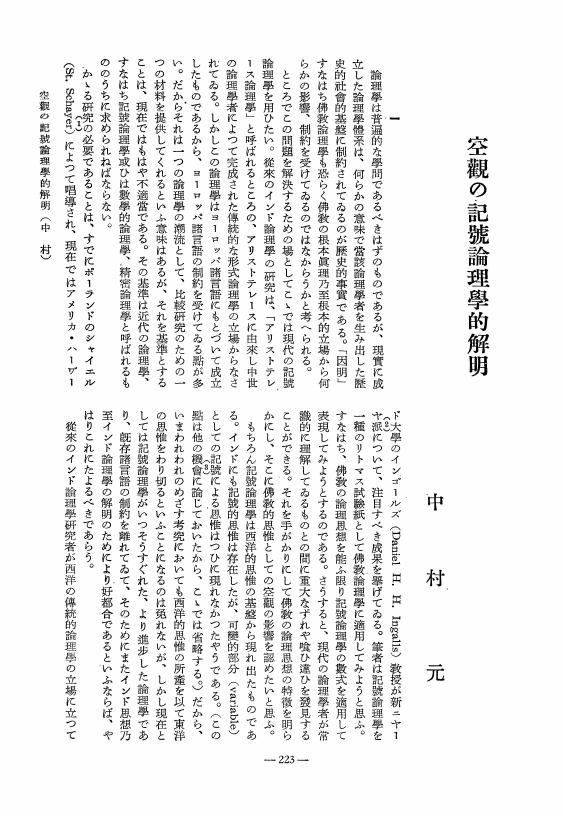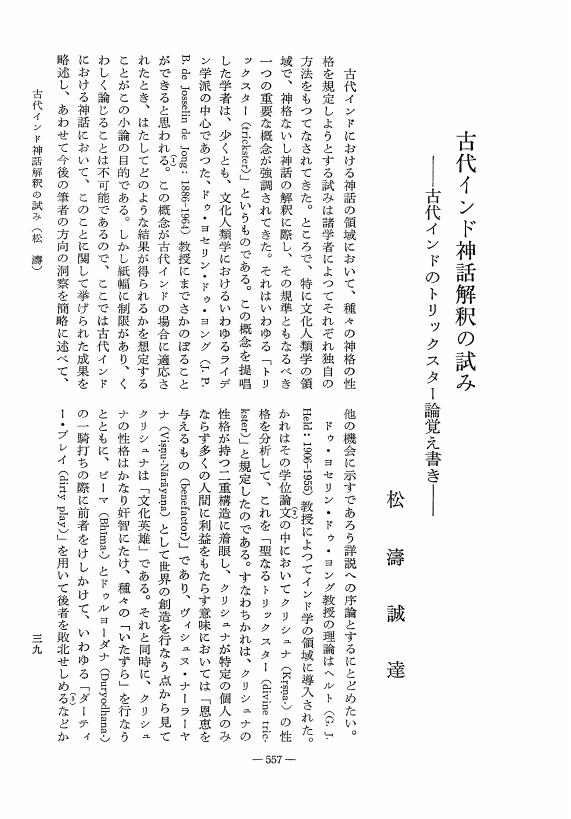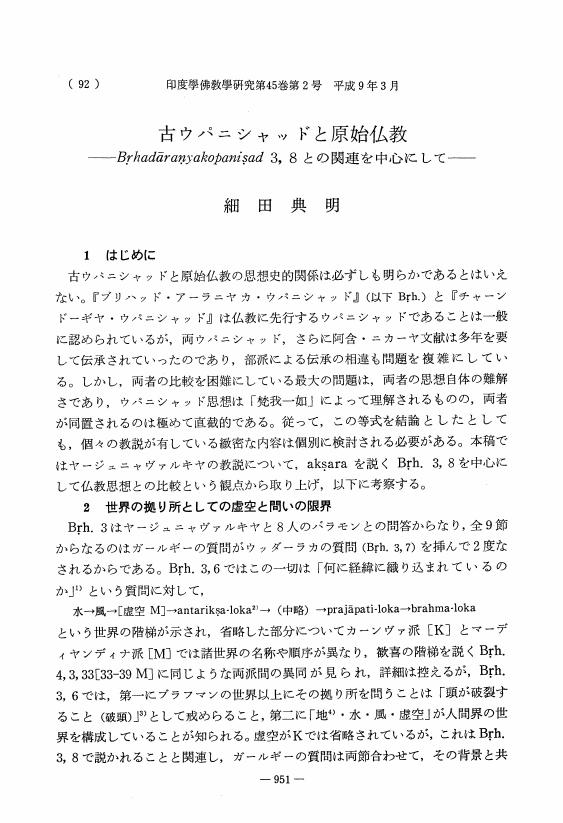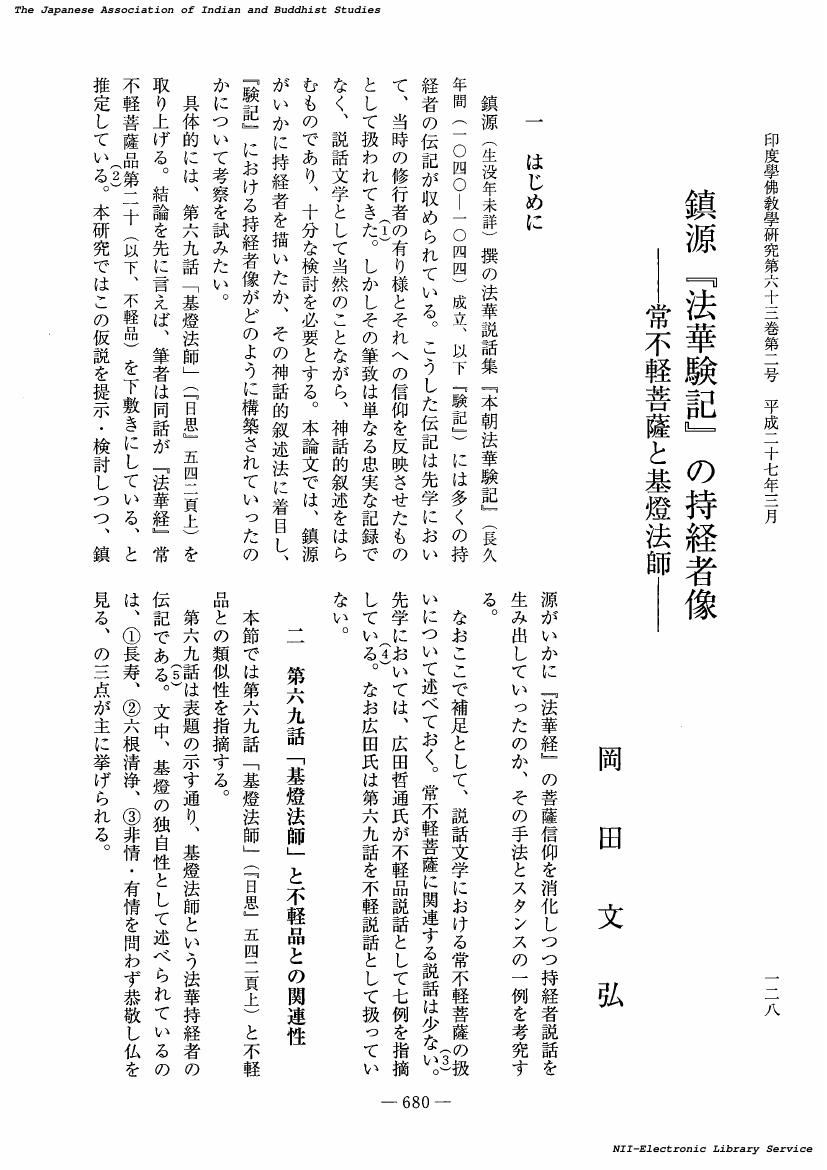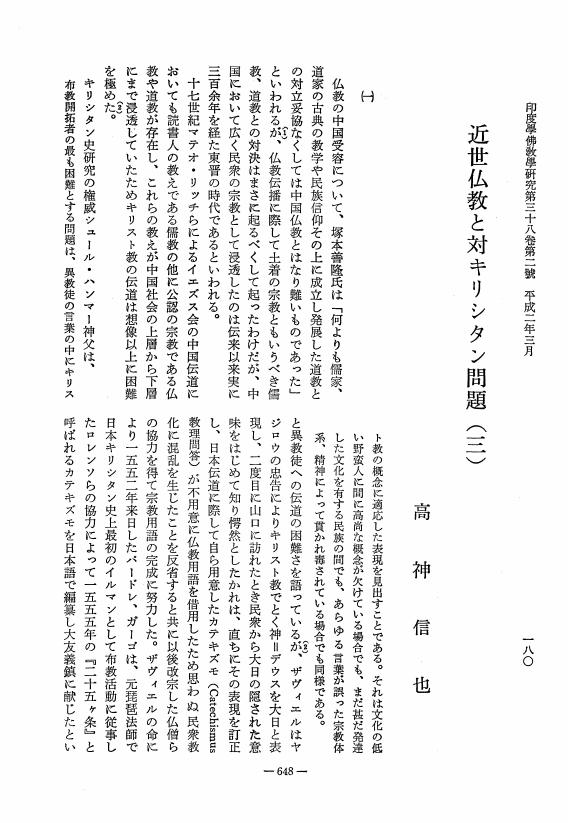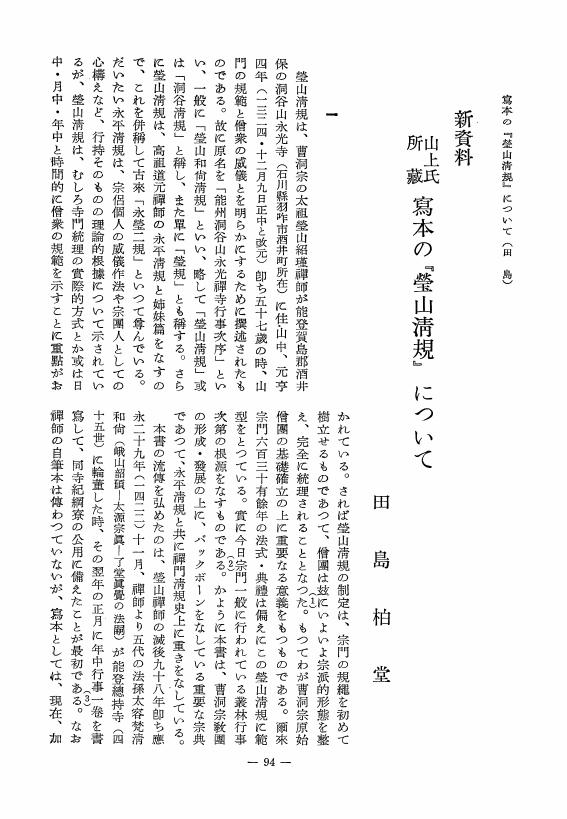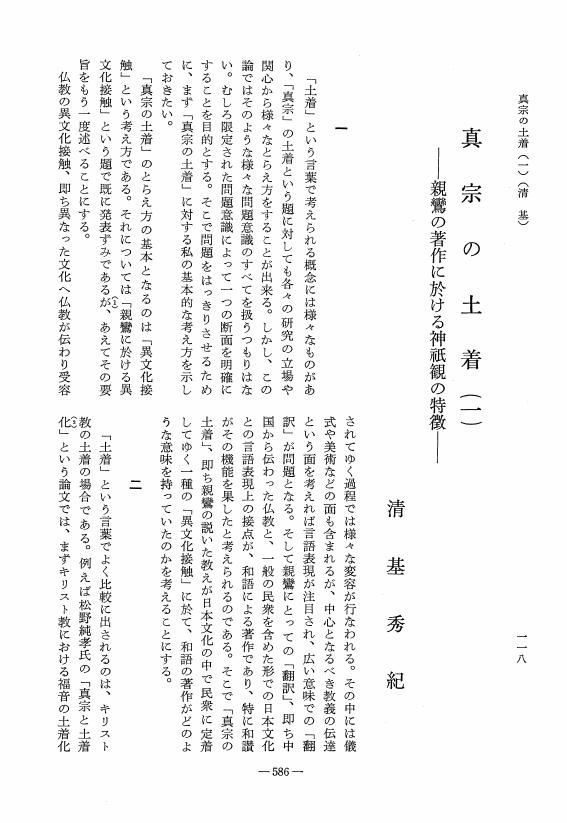2 0 0 0 OA 宮沢賢治の作品に現れた法華思想
- 著者
- 趙 明烈
- 出版者
- Japanese Association of Indian and Buddhist Studies
- 雑誌
- 印度學佛教學研究 (ISSN:00194344)
- 巻号頁・発行日
- vol.51, no.2, pp.952-948, 2003-03-20 (Released:2010-03-09)
- 参考文献数
- 6
2 0 0 0 OA 農水相を務めた禅僧・広川弘禅
- 著者
- 栗本 眞好
- 出版者
- 日本印度学仏教学会
- 雑誌
- 印度學佛教學研究 (ISSN:00194344)
- 巻号頁・発行日
- vol.70, no.2, pp.712-715, 2022-03-23 (Released:2022-09-09)
- 参考文献数
- 5
Hirokawa Kōzen広川弘禅 (1902-1967), who served as Minister of Agriculture and Fisheries under Prime Minister Shigeru Yoshida 吉田茂 (1878-1967) during the chaotic period after the war, was born as a successor to Ryūsawa Temple竜沢寺, a Sōtō establishment in Fukushima Prefecture, and studied at the current Setagaya Gakuen High School and Komazawa University. I approach him not only as a parliamentary politician, but also as a Zen priest.I pay attention to such things as his attendance, in 1956, along with Kusaba Ryūen草葉隆円 (1895-1966) and Andō Kaku安藤覚 (1899-1967), at the “Buddha’s 2500th Anniversary Celebration” held in Thailand, his installation on the roof of the Aoba Gakuen of a relic of the Buddha during his time as director of the school, and his activities as a Zen priest.In 1952, in the magazine Bungei Shunjū 文芸春秋, he was interviewed by Otis Cary in an article entitled “Monster named Hirokawa Kōzen” (広川弘禅という怪物) in which he is quoted as saying, “Japanese culture is nothing except Buddhist culture. 97% of the national treasures are related to Buddhism. … Japan’s democracy has been clear since the period of the Buddhist articulation that discrimination is equality and equality discrimination差別即平等, 平等即差別.” Concerning the Sekai Bukkyōto kaigi 世界仏教徒会議, he said, “To tell the truth, you must do it in Sanskrit or Pāli; It’s stupid to do it in English.”I would like to pursue Kōzen’s appearance as a Zen priest from the testimonies of people who interacted with him during his lifetime.
2 0 0 0 OA 空觀の記號論理學的解明
- 著者
- 中村 元
- 出版者
- Japanese Association of Indian and Buddhist Studies
- 雑誌
- 印度學佛教學研究 (ISSN:00194344)
- 巻号頁・発行日
- vol.3, no.1, pp.223-231, 1954-09-25 (Released:2010-03-09)
- 被引用文献数
- 1
2 0 0 0 OA 古代インド神話解釈の試み -古代インドのトリックスター論覚え書き-
- 著者
- 松濤 誠達
- 出版者
- Japanese Association of Indian and Buddhist Studies
- 雑誌
- 印度學佛教學研究 (ISSN:00194344)
- 巻号頁・発行日
- vol.24, no.2, pp.557-561, 1976-03-31 (Released:2010-03-09)
2 0 0 0 梵字袈裟曼荼羅の研究
- 著者
- 齋藤 彦松
- 出版者
- 日本印度学仏教学会
- 雑誌
- 印度學佛教學研究 (ISSN:00194344)
- 巻号頁・発行日
- vol.10, no.2, pp.524-525, 1962
2 0 0 0 相違決定の極小モデル
- 著者
- 上田 昇
- 出版者
- 日本印度学仏教学会
- 雑誌
- 印度學佛教學研究 (ISSN:00194344)
- 巻号頁・発行日
- vol.56, no.3, pp.1136-1144, 2008
ディグナーガの因の三相による論理学には相違決定(viruddhavyabhicarin)の現象が見られる.この現象について学者(古代,現代)は様々に説明するが,本稿は,これが特定の思想的立場に基づく論証に生ずる現象ではなく,因の三相による論証自体に内在する問題であることを明確にする.そのため,本稿は,因の三相の論理学を純粋に形式的な観点から見て,相違決定となるための必要条件を求めた上で,相違決定の極小例を提示し,相違決定の「発生現場」を捉える.相違決定の必要条件はまず喩体(遍充関係)に基づいて求められる.続いて,因の第二,三相の各々が喩体を論理的に含意することを証明する.第三相が喩体を含意することは基本的にJ.F.Staalのかつての証明に譲るが,第二相が喩体を含意すること-Staalが証明を試みたが,成功していない-の証明は新たに行う.また本稿は,因明で謂うところの「因同品」「宗同品」の概念を用いて第二相を定式化することによっても喩体が導出できることを示す.相違決定は喩体とは直接のかかわりはない.しかし,因の第二相・第三相が喩体を(論理的に)含意していることが上のようにして示されるから,喩体を基礎として得られた相違決定の必要条件は因の三相を推論の基礎としたときの相違決定の必要条件と考えてよい.従って,第二相・第三相,喩体のいずれを推論の基礎とするかに拘らず,本稿で得られた相違決定の必要条件は成り立つ.
2 0 0 0 OA 原坦山と「印度哲学」の誕生-近代日本仏教史の一断面-
- 著者
- 木村 清孝
- 出版者
- JAPANESE ASSOCIATION OF INDIAN AND BUDDHIST STUDIES
- 雑誌
- 印度學佛教學研究 (ISSN:00194344)
- 巻号頁・発行日
- vol.49, no.2, pp.533-541, 2001-03-20 (Released:2010-03-09)
- 著者
- 細田 典明
- 出版者
- Japanese Association of Indian and Buddhist Studies
- 雑誌
- 印度學佛教學研究 (ISSN:00194344)
- 巻号頁・発行日
- vol.45, no.2, pp.951-943, 1997-03-20 (Released:2010-03-09)
2 0 0 0 OA 鎮源『法華験記』の持経者像 ――常不軽菩薩と基燈法師――
- 著者
- 岡田 文弘
- 出版者
- 日本印度学仏教学会
- 雑誌
- 印度學佛教學研究 (ISSN:00194344)
- 巻号頁・発行日
- vol.63, no.2, pp.680-683, 2015-03-20 (Released:2017-09-01)
2 0 0 0 OA 近世仏教と対キリシタン問題 (三)
- 著者
- 高神 信也
- 出版者
- Japanese Association of Indian and Buddhist Studies
- 雑誌
- 印度學佛教學研究 (ISSN:00194344)
- 巻号頁・発行日
- vol.38, no.2, pp.648-654, 1990-03-20 (Released:2010-03-09)
2 0 0 0 OA 白隠禅の武芸への影響
- 著者
- 笠井 哲
- 出版者
- Japanese Association of Indian and Buddhist Studies
- 雑誌
- 印度學佛教學研究 (ISSN:00194344)
- 巻号頁・発行日
- vol.43, no.1, pp.180-183, 1994-12-20 (Released:2010-03-09)
2 0 0 0 説一切有部の成立
- 著者
- 三友 健容
- 出版者
- 日本印度学仏教学会
- 雑誌
- 印度學佛教學研究 (ISSN:00194344)
- 巻号頁・発行日
- vol.45, no.1, pp.1-11, 1996
2 0 0 0 OA 習合思想から見た憲法十七条
- 著者
- 藤田 清
- 出版者
- Japanese Association of Indian and Buddhist Studies
- 雑誌
- 印度學佛教學研究 (ISSN:00194344)
- 巻号頁・発行日
- vol.28, no.1, pp.260-263, 1979-12-31 (Released:2010-03-09)
2 0 0 0 OA Petavatthu-Atthakatha に示される anumodana
- 著者
- 藤本 晃
- 出版者
- Japanese Association of Indian and Buddhist Studies
- 雑誌
- 印度學佛教學研究 (ISSN:00194344)
- 巻号頁・発行日
- vol.49, no.1, pp.448-446, 2000-12-20 (Released:2010-03-09)
2 0 0 0 OA 山上氏所藏寫本の『瑩山清規』について
- 著者
- 田島 柏堂
- 出版者
- Japanese Association of Indian and Buddhist Studies
- 雑誌
- 印度學佛教學研究 (ISSN:00194344)
- 巻号頁・発行日
- vol.7, no.1, pp.94-104, 1958-12-01 (Released:2010-03-09)
2 0 0 0 OA 六主張論議と審判・会衆の役割
- 著者
- 小野 卓也
- 出版者
- 日本印度学仏教学会
- 雑誌
- 印度學佛教學研究 (ISSN:00194344)
- 巻号頁・発行日
- vol.59, no.2, pp.850-846, 2011-03-20 (Released:2017-09-01)
2 0 0 0 OA 神話上のアスラと史実のアスラ
- 著者
- 冨田 真浩
- 出版者
- 日本印度学仏教学会
- 雑誌
- 印度學佛教學研究 (ISSN:00194344)
- 巻号頁・発行日
- vol.69, no.1, pp.461-456, 2020-12-25 (Released:2021-09-06)
- 参考文献数
- 12
The usage of the word Asura differs depending on whether people in the past took Asura as good or evil beings. In my Ph. D. thesis, I threw light on the historical usage of the word Asura in the Vedas, Nikāyas, and early Mahāyāna sūtras, literature created before the dawn of the Common Era. I also investigated the difference between Asura in myths and human Asura, as the usage of the word Asura was applied to each group. Additionally, I found that Asura were written about not only as human beings in some situations but also as spirits in others. In a former study, I examined sūtras but did not examine Vinayas or later sources. Therefore now I use the Mahāvastu and the Datang Xiyu ji大唐西域記,a travelogue of Xuanzang玄奘,and the Datang daci’ensi sanzang fashi zhuan大唐大慈恩寺三藏法師伝,a biography of Xuanzang, and I examine the influence of the historical human Asura on the rise in mythical Asura of scriptures from various viewpoints.
2 0 0 0 OA Arjuna の懐疑に見られる意味
- 著者
- 金 浩星
- 出版者
- Japanese Association of Indian and Buddhist Studies
- 雑誌
- 印度學佛教學研究 (ISSN:00194344)
- 巻号頁・発行日
- vol.52, no.1, pp.470-465, 2003-12-20 (Released:2010-03-09)
2 0 0 0 OA 『解深密経』における玄奘・流支の縁起理解について
- 著者
- 伊藤 秀憲
- 出版者
- Japanese Association of Indian and Buddhist Studies
- 雑誌
- 印度學佛教學研究 (ISSN:00194344)
- 巻号頁・発行日
- vol.23, no.1, pp.398-401, 1974-12-25 (Released:2010-03-09)
2 0 0 0 OA 真宗の土着 (一) -親鸞の著作に於ける神祗観の特徴-
- 著者
- 清基 秀紀
- 出版者
- Japanese Association of Indian and Buddhist Studies
- 雑誌
- 印度學佛教學研究 (ISSN:00194344)
- 巻号頁・発行日
- vol.34, no.2, pp.586-591, 1986-03-25 (Released:2010-03-09)

